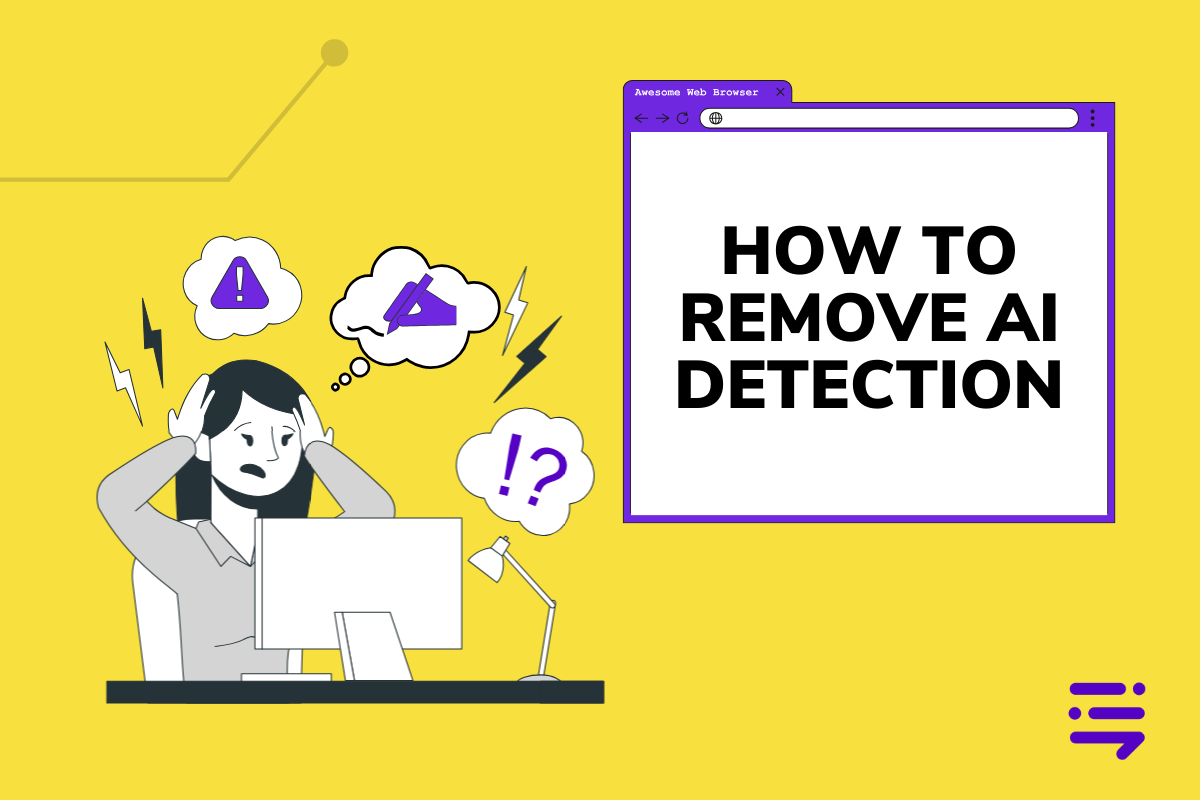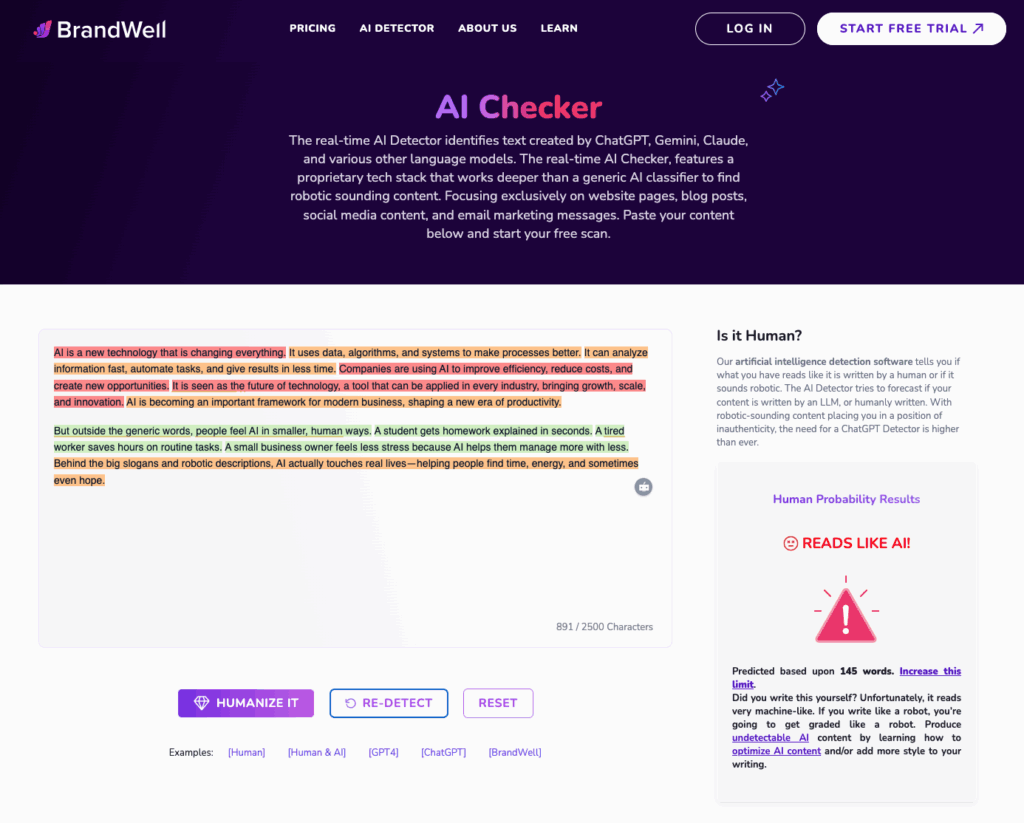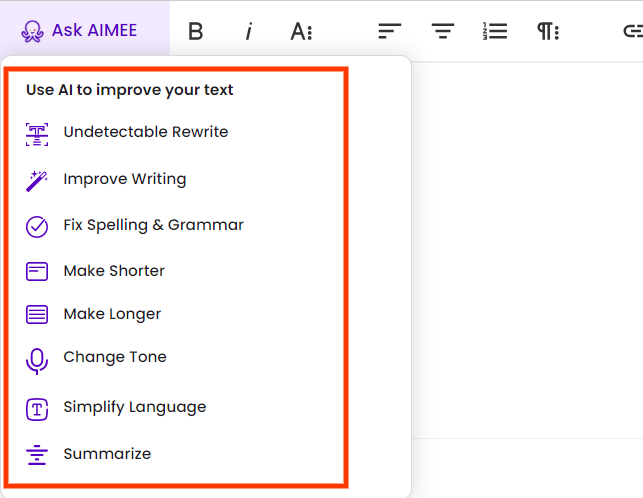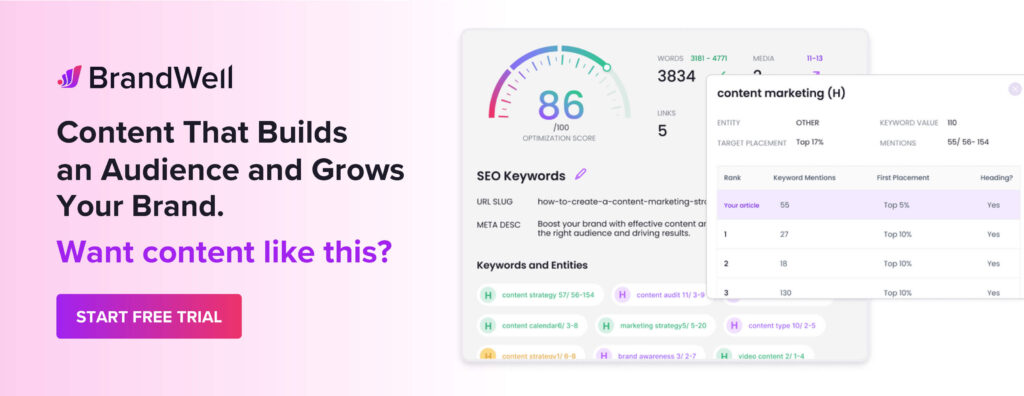Discover top guides, trends, tips and expertise from AIO Writers

The rise of AI in content creation has made it more difficult to distinguish between machine-generated and human-written content.
If you’re an SEO professional, does it matter? What does Google say about AI content?
Back in April 2022, Google said AI content violated its guidelines.
But then it softened its stance in October, banning only AI content that was spammy.
Fast forward to February 2023, when the search engine giant finally released its official guidelines on AI. They now clearly say good content is good content — no matter who wrote it.
But if you’re still worried that using tools like BrandWell or ChatGPT can make your content detectable, we can help.
This article will show you how to remove AI detection and improve your own pieces so they will bypass AI detection tools.
Table Of Contents:
- What Are AI Detection Systems?
- How to Tell if Something Was Written by AI
- Best AI Detector Tools
- How to Get Rid of AI Detection
- How to Remove AI Detection from Text
- FAQs – How to Remove AI Detection?
- Conclusion
What Are AI Detection Systems?
AI detection systems are advanced tools designed to identify AI-generated content. These systems, while often flawed, play a role in maintaining the integrity of digital content and preventing plagiarism, spamming, or misinformation associated with AI-generated text.
At its core, an AI detection system analyzes textual patterns and structures to differentiate between human-written and machine-generated content. It looks at various factors such as sentence length, word usage frequency, grammatical errors, coherence levels, semantic structure consistency, and more.
By comparing these characteristics with known human writing styles or other benchmarks established through training data sets, these detectors can help determine if a piece of text was written by an AI model.
How to Tell if Something Was Written by AI
Whether you are using ChatGPT or a specialized content marketing tool like BrandWell, it’s easy to spot technical and syntactical signs in your first draft if you know what to look for.
Some of these indicators include run-on sentences, repetition of words and phrases, lack of analysis, and inaccurate data.
Run-On Sentences
A common trait in AI-generated content is the presence of long sentences with multiple clauses. While human writers may occasionally use lengthy sentences for stylistic purposes or emphasis, they typically do so sparingly. In contrast, some AI models tend to generate longer sentence structures more frequently as they attempt to convey complex ideas.
Repetition
Another sign that a piece might be authored by an AI is the repetition of words or phrases within paragraphs. This could indicate that the algorithm has latched onto specific terms without understanding their context or importance. Human authors generally avoid these repetitions unless they’re used intentionally for effect.
Lack of Analysis and Context
- Nuance: AIs often struggle with capturing nuance in language so the output may appear overly simplistic compared to human-authored pieces.
- Critical thinking: The absence of critical analysis could also suggest AI authorship since machines are not capable of critical thinking like humans do.
- Context: AI-generated content may lack context or show inconsistencies in the overall narrative, as machines have difficulty understanding complex relationships between ideas.
Inaccurate Data And Facts
The biggest complaint with ChatGPT is its tendency to “hallucinate” or give answers that are made up.
AIs might produce content with inaccurate data or facts due to their reliance on training datasets that could be outdated or contain errors. Trustworthy human authors are more likely to verify every bit of information before including it in their writing, ensuring a higher level of accuracy and credibility.
Best AI Detector Tools
Although you can spot AI-written content manually using the tips I mentioned above, there is a more efficient way to identify machine-generated text: AI detector tools.
Some of the best AI detector tools today are BrandWell AI Detector, Undetectable AI, Originality, Copyleaks, and Giant Language Model Test Room. These apps can help you find content that sounds robot-like so you can humanize it during the editing process.

BrandWell’s AI Detector
- BrandWell AI Detector: The BrandWell AI detector helps in determining whether your text is written by a human or AI tool like ChatGPT, GPT4, Claude, and Bard. This tool combines ML algorithms and NLP techniques to differentiate between AI-generated content and human-written texts. You can run your text through its browser edition or as part of the BrandWell app.
- Undetectable.AI: Undetectable.AI offers a comprehensive suite of detection services that can identify various types of synthetic media, including deep fake videos, manipulated images, and fake audio clips. Their API allows developers to integrate their powerful detection capabilities into existing applications or build new ones from scratch.
- Originality: Originality is an innovative plagiarism checker that also detects artificially generated text using state-of-the-art algorithms. It helps users maintain high-quality standards in their writing while ensuring originality across different platforms such as blogs, academic papers, or social media posts.
- Copyleaks: Copyleaks is another popular plagiarism detection tool with added features for identifying AI-generated content. By scanning billions of web pages and databases worldwide, Copyleaks provides accurate results on whether your submitted text was created by AI or a human author.
- Giant Language Model Test Room: This unique platform allows users to interact with OpenAI’s GPT-3 language model and test its capabilities. By analyzing the generated content, users can gain insights into how AI-generated text behaves and learn to identify potential signs of artificial intelligence in written works.
These AI detector tools are crucial for maintaining the integrity of online content and ensuring that information is accurate, reliable, and trustworthy. By using these tools effectively, you can protect your work from being compromised.
How to Get Rid of AI Detection
AI detectors are not perfect. Sometimes even sentences that you wrote in your own words will be flagged by these tools as written by AI.
While these tools are designed to identify AI-generated content, there are ways you can bypass AI content detectors and make your writing less susceptible.
Add a Few Typos
One simple method for evading detection is by intentionally including typos or spelling errors in your text. Many AI algorithms have been trained on vast amounts of high-quality data and tend to produce an error-free output. By adding a few mistakes here and there, you introduce an element of “human imperfection” that might throw off the detector.
Split Long Sentences
AI writers are notorious for generating super-long sentences with complex structures. These are telltale signs of machine-generated text that are easy to detect. Try breaking up long sentences into shorter ones or rephrasing them using simpler, conversational language.
Edit Your Work
- Add personal anecdotes: Injecting personal experiences or stories into your writing adds authenticity and makes it harder for an AI detector to flag it as machine-generated.
- Rearrange paragraphs: Changing the order of sections within an article can disrupt the logical flow that AI-generated content often exhibits, making it more difficult for detection tools to identify your work as written by a bot.
- Use synonyms: Replace some of the words in your text with their synonyms. This can help you avoid repetitive language patterns and make your writing appear more natural.
How to Remove AI Detection from Text
If the previous steps sound like too much work, here’s one cool trick for totally removing AI detection from your content: unlimited rewrites!
The BrandWell AI detector now has a Pro version that not only identifies AI-generated content but also rewrites flagged sections to make them undetectable. When you choose any of the plans, you’ll get full access to AI Detector Pro at no extra cost, giving you the power to spot and perfect AI-generated content effortlessly.
BrandWell has also added generative AI to its 3.0 version, allowing you to paraphrase your text with the help of the AIMEE chatbot.


Just paste your text into the provided field and highlight the sentence you want to improve, shorten, lengthen, summarize, simplify, or change tone.
FAQs – How to Remove AI Detection?
How Do I Get Rid of AI Detection?
To remove AI detection from your content, you can either manually rewrite the text to make it sound more human-like or use a paraphrasing tool to rephrase the content. Additionally, ensure proper grammar and sentence structure, and add context-specific information that an AI might not know.
What Website Removes AI Detection?
There isn’t a specific website dedicated to removing AI detection. However, you can use online paraphrasing tools like QuillBot or Spinbot to help rephrase your content in a way that makes it less detectable.
How Do I Make a Chatbot Less Detectable?
To make a chatbot less detectable, focus on improving its natural language processing capabilities and conversation flow. Train the chatbot with diverse datasets for a better understanding of user inputs and provide personalized responses based on context. You may also consider using advanced techniques like GPT-3 from OpenAI.
Conclusion
Remember: not all AI content is bad.
Before AI came around, bad content already existed, and it was written by humans. If you want to publish good content, whether written by AI or humans, be sure to rephrase your robotic sentences, cut the fluff, and add personal stories that make your content truly human.
Never use AI to deceive search engines or readers by publishing low-quality content in bulk. Google has more advanced methods for detecting such practices, and penalizing websites that use them could result in lower rankings or even complete removal from search results.
Readers are also becoming increasingly savvy at recognizing AI writing and may lose trust in any website that uses robotic writing. This can lead to decreased engagement and ultimately harm your brand’s reputation.
While AI technology can be a useful tool for content creation, it should not replace human writers’ expertise and creativity. As an SEO or content marketer, you must ensure that your content is high quality and provides value to readers.

UNLOCK YOUR POTENTIAL
Long Headline that highlights Value Proposition of Lead Magnet
Grab a front row seat to our video masterclasses, interviews, case studies, tutorials, and guides.



